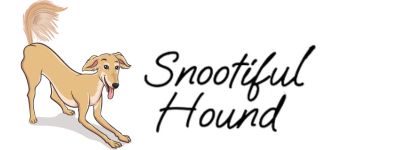So far we have found that most sighthounds adjust to wearing our sighthound harness really quickly, which makes sense as we've taken steps to make it as comfortable as possible for them.
However, as we know, sighthounds can be sensitive about trying new things, so if your sighthound hasn't worn a harness before, they may need to warm up to the idea.
If that's the case, taking a gentle and patient approach is going to be best for you and your dog, and they'll soon learn to love their new harness and enjoy the benefits it brings to them.
There can be a few different factors at play here, so I want to explore as many as possible. You don't need to focus on all of these steps, just the ones you're having trouble with.
If your dog is struggling with the steps, you don't need to do all of this in one sitting. It's important that your dog finds the experience enjoyable, so if you feel them (or yourself) getting frustrated, it's okay to stop and pick it back up another time.
These steps aren't permanent. It's all about building positive association for your dog about their new harness. Once they look forward to putting their harness on, you can phase these steps out.
Trouble putting the harness on:
If your dog is worried about putting the harness on, then we have to start from the beginning and just get them familar with their new harness. A slow approach is best here and just focus on building a positive assocation with the harness.
You can start by putting the harness on the floor and scattering your pooch's favourite treats over it, and possibly hiding treats underneath it. This will encourage them to investigate in and around the harness and find lots of yummy treats which will start to build the positive assocation.
Now we will encourage them to put their head through. Hold the harness up with one hand, or have someone else do this, and then hold treats on the other side of the head hole to encourage them to put their head through. When they do this, give them lots of encouragement and be sure to reward them with their treat.
Note, if they're having a hard time putting their head through, reward small signs of progress, e.g. getting closer, until eventually they do it, and then be sure to reward them like the rockstar they are! Ideally you want them to put their head through themselves if they're shy about it rather than you putting it over their head yourself, at least until they are used to it.
The next step is putting the paw through. It's as simple as distracting your sighthound by giving them their favourite treats as you feed their paw through. The more you do this if it is a sticking point, the more positive association you will build and they'll grow accustomed to it.
Then you just have to buckle up and you're good to go. If your dog doesn't like this step, you can use the same distraction technique from the step above.
Note - our sighthound harness no longer requires you to step into it as it has buckles on both sides, making it extra good for paw shy hounds.
Walking in their new harness:
You can start this at home, although some sighthounds may respond better on walks if they love the outdoors. It's all about making it fun!
If your sighthound hasn't worn a harness before, they may be a bit unsure about what it is. It's a lot easier to forget that it's on if they're having fun though. You know best what your dog responds to, but here are some ideas:
- Chase - if your sighthound likes to chase things, this can be a great way to get them moving. Whether you throw their favourite toy or get them to chase you, it's all about distracting them from the harness and getting them to focus on something they love!
- Other dogs - if your dog's favourite thing is to play with other dogs then they can do your job for you! On lead or off, they'll stop caring about their harness and be more interested in their doggy friend.
- Treats - if your dog responds best to treats, this can also be an effective strategy. You can either shift their focus to training drills, or one of my favourite things to do, is to call my dog, throw a treat for her, call her back, and throw another. Try to be enthusiastic and make it as fun as possible. You can also use treats to bribe your dog along on walks until they get used to it, hold the treat in front of their nose and get them to follow it for a few steps before giving it to them.
It essentially all boils down to making the experience fun and they'll soon forget their harness is on. You may have to do this a few times before your dog associates their harness with fun times, and then they'll be quite happy to put it on before walks as you'd expect.
Checking the fit:
If you've done all of the above, and your dog is still not walking properly, you may have it too tight. Check the fit and ensure you can fit two fingers all around the harness.
Happy walks:
If you've followed these steps, your sighthound will associate their Snootiful Hound harness with good times and be ready for their next adventure!
You can get your Snootiful Hound Sighthound Harness here.
You might also like this article about italian greyhound harnesses.


